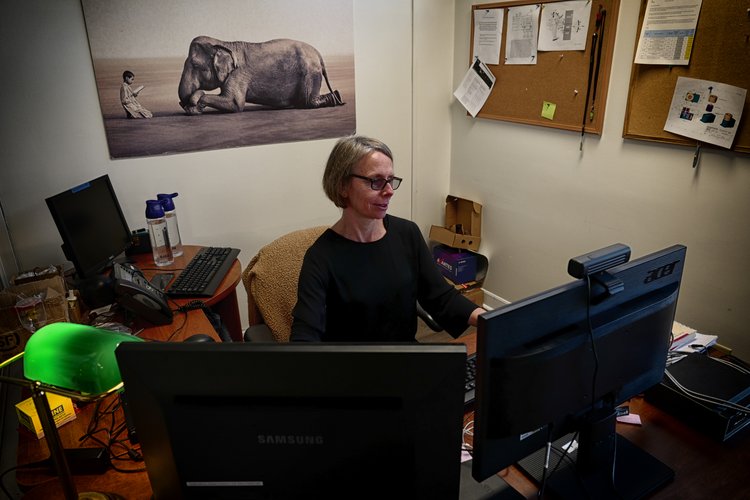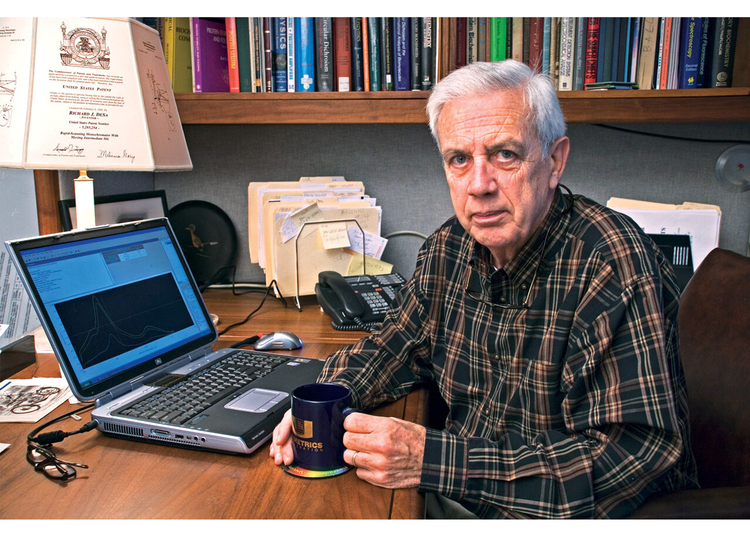The Greatest Guide To Uv/vis
The Greatest Guide To Uv/vis
Blog Article
How Spectrophotometers can Save You Time, Stress, and Money.
Table of ContentsSpectrophotometers Things To Know Before You Get ThisGet This Report about Uv/visNot known Factual Statements About Spectrophotometers Some Known Factual Statements About Uv/vis/nir The Single Strategy To Use For SpectrophotometersUv/vis Fundamentals ExplainedExamine This Report about Uv/vis/nirThe smart Trick of Uv/vis/nir That Nobody is Talking AboutThe smart Trick of Spectrophotometers That Nobody is Talking AboutNot known Facts About SpectrophotometersThe 10-Second Trick For SpectrophotometersSome Known Facts About Circular Dichroism.A Biased View of Uv/vis/nir
It is then scanned through the sample and the referral services. Portions of the occurrence wavelengths are transmitted through, or shown from, the sample and the referral. The resultant light strikes the photodetector gadget, which compares the relative strength of the two beams. Electronic circuits transform the relative currents into linear transmission portions and/or absorbance/concentration worths.The transmission of a recommendation compound is set as a standard (information) value, so the transmission of all other compounds are recorded relative to the preliminary "zeroed" substance. The spectrophotometer then transforms the transmission ratio into 'absorbency', the concentration of specific parts of the test sample relative to the preliminary substance.
Given that samples in these applications are not readily offered in big amounts, they are especially matched to being evaluated in this non-destructive strategy. In addition, valuable sample can be conserved by making use of a micro-volume platform where just 1u, L of sample is needed for complete analyses. A brief explanation of the procedure of spectrophotometry includes comparing the absorbency of a blank sample that does not contain a colored compound to a sample that includes a colored compound.
Rumored Buzz on Uv/vis
In biochemical experiments, a chemical and/or physical residential or commercial property is chosen and the treatment that is utilized is particular to that residential or commercial property in order to derive more info about the sample, such as the quantity, purity, enzyme activity, etc. Spectrophotometry can be utilized for a number of techniques such as figuring out optimum wavelength absorbance of samples, identifying optimal p, H for absorbance of samples, determining concentrations of unknown samples, and identifying the p, Ka of numerous samples.: 21119 Spectrophotometry is likewise a helpful process for protein purification and can also be used as an approach to develop optical assays of a substance.
It is possible to understand the concentrations of a two component mixture using the absorption spectra of the standard services of each part. To do this, it is needed to understand the extinction coefficient of this mixture at 2 wave lengths and the termination coefficients of options which contain the recognized weights of the 2 elements.

Excitement About Circularly Polarized Luminescence
Area. The concentration of a protein can be estimated by measuring the OD at 280 nm due to the presence of tryptophan, tyrosine and phenylalanine.
This technique requires a spectrophotometer capable of determining in the UV region with quartz cuvettes.: 135 Ultraviolet-visible (UV-vis) spectroscopy involves energy levels that excite electronic shifts. Absorption of UV-vis light thrills molecules that are in ground-states to their excited-states.
20. 8 O.D. Ink manufacturers, printing companies, textiles suppliers, and a lot more, need the data supplied through colorimetry. They take readings in the region of every 520 nanometers along the visible region, and produce a spectral reflectance curve or an information stream for alternative presentations. These curves can be utilized to test a brand-new batch of colorant to check if it makes a match to specifications, e.
The 5-Minute Rule for Circular Dichroism
Traditional noticeable area spectrophotometers can not detect if a colorant or the base product has fluorescence. This can make it difficult to manage color issues if for instance several of the printing inks is fluorescent. Where a colorant contains fluorescence, a bi-spectral fluorescent spectrophotometer is utilized (https://visual.ly/users/julieanndesalorenz30606/portfolio). There are 2 major setups for visual spectrum spectrophotometers, d/8 (spherical) and 0/45.
Researchers utilize this instrument to measure the amount of compounds in a sample. If the compound is more concentrated more light will be taken in by the sample; within little ranges, the Beer, Lambert law holds and the absorbance between samples vary with concentration linearly. In the case of printing measurements 2 alternative settings are frequently utilized- without/with uv filter to manage better the result of uv brighteners within the paper stock.
Facts About Uv/vis/nir Revealed
Some applications need little volume measurements which can be performed with micro-volume platforms. As described in the applications section, spectrophotometry can be used in both qualitative and quantitative analysis of DNA, RNA, and proteins. Qualitative analysis can be utilized and spectrophotometers are utilized to tape spectra of substances by scanning broad wavelength areas to determine the absorbance residential or commercial properties (the strength of the color) of the substance at each wavelength.

The Best Strategy To Use For Circularly Polarized Luminescence
One significant factor is the type of photosensors that are readily available for various spectral regions, however infrared measurement is also difficult due to the fact that virtually whatever gives off IR as thermal radiation, specifically at wavelengths beyond about 5 m. Another issue is that several products such as glass and plastic absorb infrared, making it incompatible as an optical medium.
Samples for IR spectrophotometry might be smeared in between 2 discs of potassium bromide or ground with potassium bromide and pushed into a pellet. Where liquid services are to be determined, insoluble silver chloride is utilized to build the cell. Spectroradiometers, which operate nearly like the noticeable area spectrophotometers, are created to determine the spectral density of illuminants. 2013. p. 13. Allen, DW; Cooksey, C; Tsai, BK (Nov 13, 2009). "Spectrophotometry". Obtained Dec 23, 2018. Ninfa AJ, Ballou DP, Benore M (2010 ). Basic Lab Methods for Biochemistry and Biotechnology (2nd ed.). Hoboken: Wiley & Sons. ISBN 9780470087664. OCLC 488246403. Schwedt G (1997 ). The vital guide to analytical chemistry.
Oke, J. B.; Gunn, J. E.
Everything about Circularly Polarized Luminescence

Ninfa AJ, Ballou DP, Benore M (2015 ). Basic Lab Techniques for Biochemistry and Biotechnology (3, rev. ed.). circularly polarized luminescence. Lab Equipment.
The Ultimate Guide To Spectrophotometers
"Applied Spectrophotometry: Analysis of a Biochemical Mix". Biochemistry and Molecular Biology Education. Journal of Biochemistry Education.
The Only Guide to Spectrophotometers
U.S. Department of Commerce National Bureau of Standards special publication; 378. Washington, D.C.: U.S. National Bureau of Standards. p. 2. OCLC 920079.
The process begins with a regulated light source that lights up the examined sample. In the case of reflection, as this light connects with the sample, some is soaked up or produced. The given off light journeys to the detector, which is examined, measured, and provided as industry-standard color scales and indices.
All terms are assessed over the visible spectrum from 400 to 700 nm. In the case of transmission, when the light communicates with the sample, it is either absorbed, reflected, or transferred.
The smart Trick of Uv/vis That Nobody is Talking About
Examples consist of APHA (American Public Health Association) for watercolor and purity analysis, ASTM D1500 for petrochemical color analysis, edible oil indices utilized in food, and color analyses of drinks. All terms are evaluated over the noticeable spectrum from 400 to 700 nm.
Image Credit: Matej Kastelic/ Dr. Arnold J. Beckman and his coworkers at the National Technologies Laboratories initially developed the spectrophotometer in 1940. In 1935 Beckman established see this website the business, and the discovery of the spectrophotometer was their most ground-breaking invention. Dr. Bruce Merrifield, a Nobel prize-winning biochemist, stated that the invention of the spectrophotometer was "probably the most important instrument ever developed towards the development of bioscience." Before the discovery of the spectrophotometer, chemical analyses took weeks to complete, with 25% precision.
The Best Strategy To Use For Circularly Polarized Luminescence
Over time, scientists kept enhancing the spectrophotometer design to enhance its efficiency. The UV abilities of the model B spectrophotometer were enhanced by replacing the glass prism with a quartz prism.
After 1984, double-beam versions of the gadget were developed. The addition of external software with the arrangement of onscreen display screens of the spectra can be found in the 1990s. Usually, a spectrophotometer is comprised of two instruments, namely, a spectrometer and a photometer. A fundamental spectrophotometer includes a light source, a monochromator, a collimator for straight beam transmission, a cuvette to place a sample, and a photoelectric detector.
Unknown Facts About Circularly Polarized Luminescence
There are various kinds of spectrophotometers in different shapes and sizes, each with its own function or functionality. A spectrophotometer identifies how much light is reflected by chemical parts. circular dichroism. It determines the difference in light strength based on the overall amount of light presented to a sample and the amount of beam that goes through the sample solution
A spectrophotometer is used to figure out the concentration of both colorless and colored solutes in a service. This instrument is utilized to determine the rate of a reaction.
Report this page